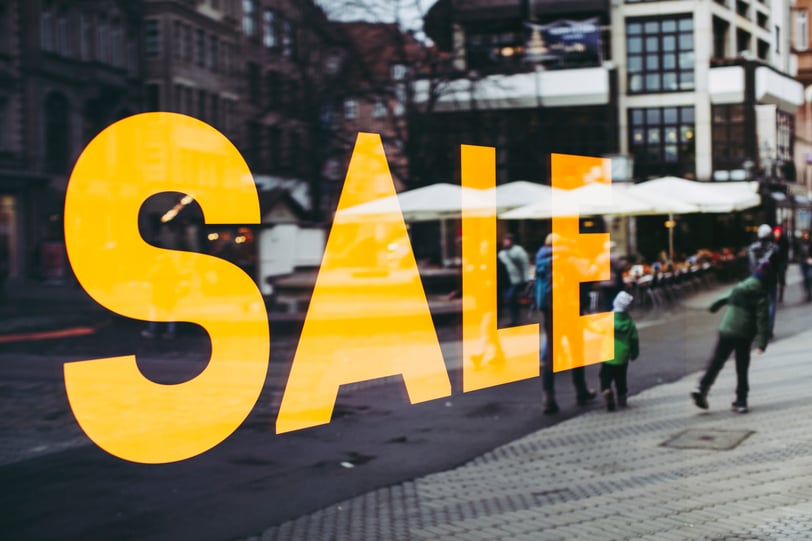Outbound Prospecting: Reach more MedTech OEMs at the right time
August 30, 2023 | Kevin Saem, Ph.D. |
MedTech Business Development

Introduction
The medical device industry is expanding daily--new technology, vendors, manufacturing practices, and new iterations of medical intervention never seen before. Behind every medical device, product, or service, there are designers, developers, engineers, manufacturers, consultants, buyers, sellers, and service providers (to name a few).
The industry is large but the networks are small. Even so, chances are if you're providing a product or service to a medical device OEM, you're not the only business offering that service. In selling, there comes a point where word-of-mouth only gets you so far before you need to start proactively looking for more business. Enter outbound prospecting, a way of expanding your reach as a vendor beyond traditional word-of-mouth in B2B (business-to-business) selling.
The Difference Between Inbound and Outbound
Before a business becomes a customer, they are considered a prospective customer, or prospect. Continuous selling requires businesses to vet these prospects to generate qualified leads (the prospects most likely to buy your product or service). There are two main types of leads, inbound leads, and outbound leads.
Inbound leads are potential customers who initiate contact. Typically, inbound leads are generated through inbound marketing (website content, advertising, or free resources that make potential customers want to talk to you about your product or service).
These leads have a higher chance of becoming actual customers due to their genuine interest in your product or service. It is important to prioritize these leads and engage with them in a timely manner.
Outbound leads are the opposite. These are people or businesses who don't know about your business, product, or service; whether or not they have a need for what you do. Where inbound leads initiate contact with you, outbound leads require you to make first contact.
Contacting outbound leads involves sending emails, making cold calls, engaging on social media, or going to trade shows and conferences to meet specific decision-makers in the OEMs you're reaching out to. Because outbound leads don't first come to you, they probably don't have an understanding of your product or service. This means you need to first educate them to see if there's a good fit between what you offer and what they might need.
The Prospecting Mindset
Outbound sales prospecting is challenging. It's a motion that, when done right, leads to more customers and expanding networks. But in a B2B environment, selling isn't the goal of outbound prospecting efforts.
When trying to connect with someone who is unfamiliar with you, your offerings, or the potential value they hold, the aim is to initiate a dialogue that enables you to inform and assess their level of interest. The outbound selling process is the tip of the iceberg in a buying process that builds trust and confidence in your potential customers.

The Limitations of Relying on Inbounds and Word of Mouth
Any business with existing customers and a good reputation has created a powerhouse of future potential business--from the credibility, trust, and rapport of current customers, and the benefit of those satisfied customers spreading the word about what you do and how well you do it.
However, relying only on existing customers and networks to spread the word about your business limits your growth. Chances are there are far more people who have not heard about what you do than the number of people who are aware of what you offer.
Only relying on inbound leads can:
-
- Limit your reach to only existing networks
- Slows sales productivity and the ability to scale your business
- Create a skewed dependence on external factors and referrals for future business
- Cause missed opportunities outside of your immediate network
To reach the greatest number of potential customers, businesses that are seeing sales success are leveraging a multi-channel approach of inbound and outbound leads for identifying potential customers.
The Nuances of Selling to Medical Device Companies
Since you're in the business of selling to medical device companies, you need to understand your target market--the particular device type, development phase, size, and experience level of the OEM you're offering your services to. Being specific about your product or service makes it more relevant to someone who may not be familiar with it and helps define your sales prospecting process.
When selling to medtech OEMs, it's important to consider the standards they must comply with. Suppliers and vendors who work with these companies typically need to obtain the same certifications. Since the medical device industry is heavily regulated, failing to obtain a necessary certification could result in a loss of business, and vendors should familiarize themselves with the various industry certifications and standards when selling to MedTech OEMs.
"We Already Have a Vendor For That"
Vendor/Supplier relationships in MedTech often last years. When reaching out to an OEM with limited context, it's important to keep this in mind. To emphasize the prospecting mindset, the goal of your outreach should be to start a conversation that enables you to inform and assess their level of interest. If there is an established relationship, you'll need to highlight how your product or service takes a different approach and highlight those differences between you and the current vendor.
Identifying Need
If there isn't a vendor in place for what you offer, you'll need to identify if there is an active need for what you offer. If a need exists, either there's an ongoing effort to find a solution, or there's no motivation to find a solution. Being prepared to handle any scenario requires you to have a clear value proposition to help communicate what you're offering is worth in money, time saved, or some other element that adds value.
To be clear, a value proposition isn't a sales pitch, it's a point of differentiation between what you offer compared to another vendor, or compared to the status quo. People don't buy sales pitches, they buy what's going to be more valuable to their business.
A key takeaway here is that selling isn't about convincing prospects you're better than the competition, it's about aligning what you have with what's important to your prospect.
Crafting an Effective Outbound Sales Prospecting Strategy
Effective sales prospecting methods use a mix of outreach efforts, but they all have one goal in mind--uncover qualified leads and prospective buyers to close business and generate revenue. Before a prospect enters your sales cycle, here are some sales prospecting tips to follow before reaching out.

Why Research is Important
The beginning of your research involves understanding the nuances of selling to medical device companies. When reaching out to a company, it's critical to show what you know about that business in your outreach. One of the best ways to conduct company research is using digital tools as 'personal research assistants.'
Google Search is the most popular option but also requires proactiveness to look for the right information. The more effective way to conduct MedTech company research is using some form of automation to deliver the specific information you're looking for to you in a 'digest.'
Google Alerts is an option to set-up notifications for specific search terms, but has limitations in automated deep search and trigger events that are not optimized for search like funding announcements, company letter releases, or clinical trial recruiting. If you're selling to MedTech OEMs, it's best to use an industry-specific tool that can provide the research you need, including the associated trigger event that prompted your outreach.
Targeting Personas
Once you've compiled your research and have a good idea about what the business does and how your product or service can specifically benefit your potential buyers, it's time to identify who you're going to reach out to, this is your ideal customer. It's helpful to build a buyer persona for your ideal customer--a representation of characteristics, behaviors, needs, preferences, and challenges of a specific group of potential buyers.
Creating a persona will help you tailor your messaging to be relevant to a person, not just a business, and provide the path of least resistance to starting a discussion in identifying qualified leads.
A few elements to consider when creating a buyer persona are:
.png?width=904&height=490&name=BLOG%201%20Graphics%20(1).png) Creating a persona helps guide who you will be contacting at any given company. It enables you to craft messaging that will be the most relevant and engaging. And this isn't just a one-off effort. At each company you reach out to, it's helpful to always target the same personas.
Creating a persona helps guide who you will be contacting at any given company. It enables you to craft messaging that will be the most relevant and engaging. And this isn't just a one-off effort. At each company you reach out to, it's helpful to always target the same personas.
For example, if you're a CRO reaching out to OEMs in clinical trials, you might always reach out to the Clinical Director. Most Clinical Directors have similar responsibilities and pain points across all companies, and the nuances appear in personality, market focus, and experience level. Once you have a good understanding of the common cares and challenges of the Clinical Director persona, you can confidently reach out to any clinical director and initiate an engaging and relevant conversation.
After creating your buyer personas, a great tool for identifying the people behind those personas is LinkedIn or LinkedIn Sales Navigator. These platforms can help you pull together your knowledge about your target personas with your research into personalized messaging for outbound sales success.
Why Personalization Matters
Personalization begins with relevance, and relevance shows you've done your research. General emails that could be applicable and sent to hundreds of people at once are nothing but spam. Combining your research and targeting efforts, your prospecting process should demonstrate you have more than a surface-level knowledge about the persona you're contacting and have a general understanding of the cares, focus areas, goals, and challenges of the business they work in.
Here’s an example of a persona-specific but not-personalized email:
Hi Ruth,
Since you’re a Clinical Specialist at ABC Biotech, you’re probably worried about
capturing the right data, at the right time, from the right site. I’d love to show you how our
Clinical Trial Management Software can help you with that.
Do you have 15 minutes this Tuesday or Thursday to connect?
Very best,
Dan
This email captures Ruth’s persona, her role, the company she works for, and what she might care about, but lacks any personal tie to Ruth. This email could be sent to 100’s or Ruth’s simply by changing the recipient name and company email.
To write a more personal email, try looking for a recent piece of news or a social media post from the company you're contacting as a jumping-off point for personalization.
Here are some examples to consider relevant to MedTech OEMs:
- Medical Device Recalls or Quality Issues
- FDA Clearances or Submissions
- Recent Conference or Trade-Show Attendance
- Clinical Trial or Funding Announcements
- OEM Mergers or Acquisitions
- Hiring Announcement
- Industry Trends and Direction
- Emerging Technology and Breakthroughs
- Management Changes
- New Hires
- Expansion or New Facility Construction
- Clinical Trial Recruitment Notifications
Here’s that same email written with a more personal touch incorporating some more specific information available through research.
Hi Ruth!
Exciting news about ABC Biotech’s recent clinical trial announcement! You’re probably
expecting to be super busy getting ready for data collection and site setup. One of the
areas I’ve seen take the most effort for clinical specialists is capturing the right
data, at the right time, from the right site. We just helped COMPANY NAME with this
same process and saved HH hours in data analysis. Curious if you’re open to any
help in this area?
Very best,
Dan
The difference here is leveraging not only what you know about Ruth’s persona, but also relevant and well-timed company specific information which connects back to what she can expect to be going through in real time and offers an organic way to bring up how your product or service is uniquely positioned to help her.
Creating a Prospecting Cadence
Working with a cadence is the best way to keep yourself organized and efficient in your outbound sales prospecting process. A cadence is a list of steps at determined intervals that define whether you will make a phone call, send an email, or message someone via social media (LinkedIn) on any given day.
Here is a typical outbound cadence example using a mix of contacting efforts:
.png?width=960&height=540&name=BLOG%201%20Graphics%20(3).png)
It's important to have a mix of contact methods in a cadence because some people may not check their email, but they'll answer the phone. For others, the opposite might be true. If you're reaching out to a more established medtech OEM with less than 50 employees--which represents most of the market--most of the time you won't find many employees outside management and C-suite active on LinkedIn or with direct numbers, in which case email can be powerful.
How to Keep A Cadence Organized
If you're reaching out to multiple outbound prospects every day, your prospecting process can be cluttered with calls, emails, and social media interactions. This is a recipe for confusion about which cadence steps your sales prospects are on. It's helpful to have a method of organizing these steps into one location for each prospect.
This could be as simple as an Excel or Google sheet where you create lists of sales prospects and manually change which stage they're on and what date you last interacted with them in that spreadsheet. Google Sheets has a helpful CRM template to get you started for free titled "Customer Relationship Management."
Automating Your Cadence
If you want more automation in tracking these steps, there are far more options available. For the budget conscious, there are many ways to outfit various free task manager tools as "cadence managers" for organizing steps. But for those willing to make the investment there are numerous sales prospecting tools that allow you to pre-define the steps in a cadence and the tool will automatically track these for you and advance each prospect to the next step of the cadence.
Prospect Response Modes
As you prospect, expect a mix of responses. Some people will be interested and want to learn more, others will hang up on you, get upset at you for calling, may tell you to stop emailing them, or just be entirely unresponsive. Any of these responses is okay because it gives you clarity on where to spend your time.
If someone says to stop reaching out to them, be mindful that these are people you are reaching out to, with jobs, responsibilities, and lives of their own. It's not your job to convince them why they're wrong or send a witty reply--simply acknowledge their response and agree to their wishes.
Finishing a Cadence
Once a prospect finishes a cadence, what do you do with that person? Most sellers don't have a plan for this and those sales prospects that finish a cadence and forgotten about as "unresponsive." The best practice is to leave yourself a reminder to reach out to those people in a quarter or two, not with the same cadence as before, but with 2-3 emails reminding that person of your prior outreach and asking if now is better timing.
You can set these types of reminders with sales prospecting tools, a task manager, or right in your Gmail inbox. A lot can change in a MedTech business from quarter to quarter, and your product or service may be more relevant in the future--timing is everything.
Building Momentum
Where your sales prospecting efforts become very powerful is when you've been keeping up with the same prospects over multiple quarters or in some cases years. The time in between quarterly or bi-quarterly touches is a great opportunity to follow your prospects on social media channels and engage with content posted by them or their company. Over time, this helps to build familiarity and communicate that you're looking to establish a relationship for a long-term business partnership, and not just a sales transaction.
Tracking Key Metrics for Prospecting Success
There's a quote attributed to Peter Drucker which is often used outside its intended context, but is arguably most relevant to sales prospecting: “What gets measured gets improved.” Outbound sales prospecting success is a numbers game. Even if you spend time crafting the most personalized, relevant, and respectful email, you may not get a response.
It's important to find a balance between quality and quantity. On one hand, you don't want to spend too much time on each email or social media interaction, as this can be time-consuming. On the other hand, you don't want to come across as impersonal by sending the same generic message to every prospect, as this can make you seem like a spam bot.
Striking a balance between quality and quantity is key to effective outreach, and there are some essential key performance indicators (KPIs) for measuring effectiveness that will help you make those tweaks. Here are some KPIs to track and how this data helps you improve your sales prospecting process.
Response and Conversion Rates
In outbound sales prospecting, the goal is not to make a sale. The goal is to create the space for a conversation that allows you to gauge interest in what you're offering. This is more of a mindset than anything, and informs the two primary conversion rates to track in outbound sales prospecting:
- Call-to-Meeting Booking Conversion Rate: measures how many calls you need to make in order to secure a booked meeting
- Email-to-Meeting Booking Conversion Rate: measures how many emails you need to send in order to secure a booked meeting
Tracking these sales prospecting metrics over time informs how effective your email messaging and cold calls are landing with your buyer personas. Making adjustments based on these metrics helps to improve these conversation rates so that you don't have to send so many emails and make so many calls before speaking to a potential customer and seeing greater sales success.
Ensure Message Effectiveness
Evaluating and re-evaluating the messaging used to reach potential customers keeps a pulse on how effective and relevant your outreach is. Generally speaking, when reaching out to a MedTech OEM, you'll be contacting one or more of these roles:
.png?width=960&height=540&name=BLOG%201%20Graphics%20(4).png)
The roles you reach out to will change based on the type of OEM you're reaching out to, their development phase, and the experience level of those running the business--are they experienced or inexperienced in their roles? What are their pain points? How big is their team? Are you reaching out to potential buyers directly or their direct reports?
Keep in mind that executives, managers, individual contributors, and consultants may all have different priorities when it comes to your product or service. Therefore, it's a good idea to experiment with various messaging strategies when reaching out to potential customers to determine which approach results in higher sales prospecting conversion rates.
Maximize Conversion Rates with Less Research
Effective sales prospecting begins with relevant messaging sent at the right time, and MedTech vendors who are proactive about reaching out to prospective customers earn new business and grow their networks. Identifying the right time to reach out is the hardest part about outbound sales prospecting; if you're too early, you're not relevant, if you're too late, your prospective buyer has already chosen another vendor.
As the only personal sales prospecting research assistant for MedTech, Zapyrus enables vendor engagement with OEMs at exactly the right time. Instead of spending hours researching companies and guessing at relevant messaging, vendors can be notified of trigger events that signal the best time to make contact with potential customers.
Let us know what you think.
________________________________________________________________________
Are you considering investing in a sales intelligence platform?
Let us show you how Zapyrus can help you create meaningful outreach without digging through NIH abstracts, clinical trials databases, device approval databases or endless google searches.

.png?width=960&height=540&name=BLOG%201%20Graphics%20(2).png)





